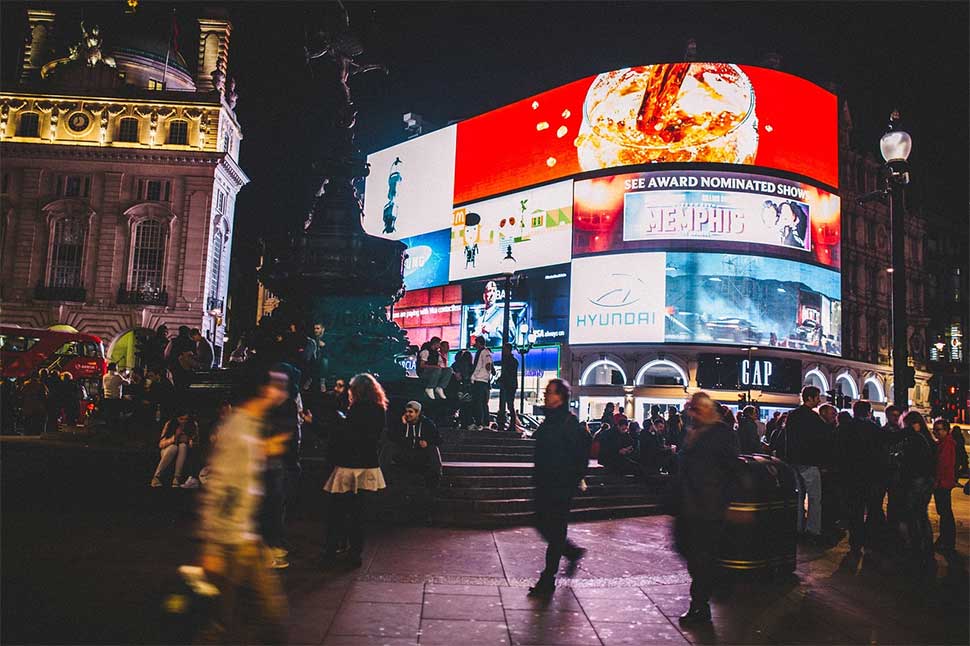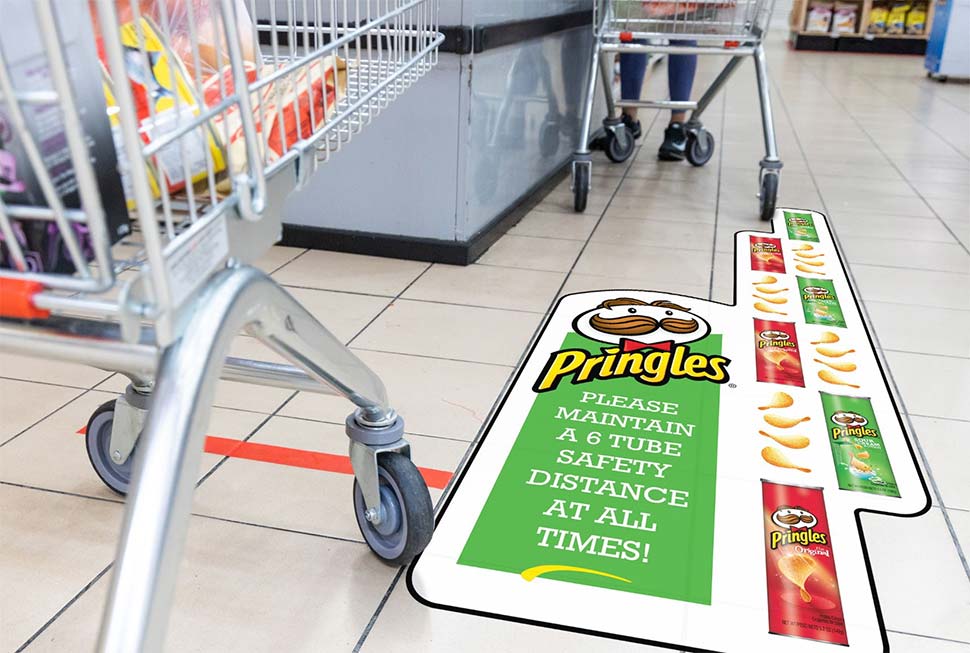Given the advancements in digital advertising technology and its rising popularity among marketers, LFR considers some of the core challenges this poses to printed signage work and what the industry can do to respond.
- When it comes to digital signs, a key pitch is that they can be updated and changed very easily.
- All digital signage requires an initial capital outlay on the hardware and software, while running and maintaining these screens can be much more costly than is often suggested primarily because the creation of professional grade video content is very expensive.
- How can print and digital screens best combine to deliver greater value for the client and have the maximum impact on consumers or passers-by?
Electronic signage and what it means for print as a media within the signage and retail display market; it's a major subject that the print and signage industries are all too aware of, but also a subject that is not talked about anywhere near enough.
While digital screens have been around for some time now, advancements with this technology in recent years has led to more questions being raised about the role print has to play in the future of signage.
Take Piccadilly Circus as an example; since the switch to LED-based signage in the 2000s, advertisers have not looked back, with signage at the famous London site being programmed to do all sorts of weird and wonderful things to catch the attention of passers-by. And in an increasingly digital world where the attention of consumers can often be hard to come by, brands, retailers and marketers are having to work harder to do this.

Piccadilly Circus in London is now dominated by huge digital screens as brands seek to capture the attention of passers-by in a digital world.
With this in mind, one cannot help but be concerned about how printed media can compete with the all-singing, all-dancing bright lights of digital signage. However, all hope is not lost; there remains plenty of scope for printed signage, with this tried and trusted media continuing to outdo its digital cousin in certain areas.
Here, we compare and contrast some of the pros and cons of working with both printed and digital signage, mapping out how rather than competing against one another, the two medias can run side-by-side in eye-opening, thought-provoking multimedia campaigns.
Flexibility and interactivity
Let us begin with the obvious point – the pure flexibility of digital content. When it comes to digital signs, these can be updated and changed very easily, allowing for one site to display multiple messages from a brand or several brands, thus maximising their potential in terms of generating revenue.
The same can also be said of making updates to or maintaining signs, with the ability to almost all of this remotely from a warm office, often hundreds of miles away from where the sign is located.
Add in that digital signage offers brands the opportunity to include both video and audio elements, as well as interactive elements to draw in consumers, and it is easy to see why this has become a popular choice. One only has to look at the case study pages of JCDecaux, Ocean Outdoor, Clear Channel et al to see excellent examples of this.
In contrast, static print is more limited in terms of flexibility. Printed signs show a fixed message that can only be updated by installing new printed signage. Brands have to plan ahead to ensure content is ready when the time comes to launching a new message or campaign, while the actual installation of signage can take time. For example, if the weather conditions are not with you, then installing the sign may have to wait, reducing its impact time on the consumer.
There is also the issue of only limited interactivity. Brands can integrate features such as QR codes and augmented reality (AR) to allow consumers to scan the printed signage and access additional feature on their smartphone, but this is a far cry from some of the interaction possible with digital signs.
Assessing the situation
Digital signage can take the messaging capabilities further by providing video demonstrations on the use of a product, as well as additional information with touchscreens. For this reason, screens are seen as the best choice in certain environment and situations where print would only be able to offer limited information. Examples of this include hospitals and clinics, hotels and restaurants, and busy transports centres such as airports – could you imagine going away on holiday without checking those electronic departure boards?
However, while there is no doubt that digital technology is far advanced than that of print in some areas, this is by no means the be-all and end-all when it comes to signage. As impressive as this tech may be, it might not be the right fit for all types of signage and, in many cases, print remains the best choice.
One example of this is when promoting an individual product inside a store or providing important information. These sign types can be moved around easily and provide the consumer with longer dwell time to digest the information on these signs, whereas with digital screens, these tend to flick through information and only limited time for consumers to consume it all. Our reference to the airport departure boards even rings true here; if it is a single screen flicking through pages, you may have to wait for your flight information to circle back around again.
For this type of signage in action, one only needs to look at the floor graphics that helped us to move around safely during the pandemic. While providing only simple messages such as “One Way” or “Keep 2m Apart”, these highly impactful signs were a vital weapon in the battle against Covid-19 and, due to their location below our feet both inside and outside, meant print was the only way to go.

Certain signage, such as floor graphics, are only possible with print.
Printed signage can also be placed in a wider range of locations without having to take into account power access. If there were to be a power cut and no backup generators were in place, the screen would be rendered temporarily useless. On the flip side, with print, as long as there is some form of light – be it natural or artificial – the message will remain.
Digital challenges
Aside from energy access, digital sign faces a number of other challenges that, in both the short- and long-term, mean print’s position as a sought-after medium in signage work will remain. One such issue is the cost of digital signs, both in terms of getting the signage in place and the running of the screen.
All digital signage requires an initial capital outlay on the hardware and software, while running and maintaining these screens are much more costly than print-based signage. Add in how many screens need to run 24 hours a day, 365 days of the year, and with the cost of energy crisis we have been living through, one can only imagine how much this will cost the brands looking to make use of the screens.
Next, the environment. Much has been said and written about print’s impact on the world around us – with large portions of these claims not fully true or accurate – while only little has been published about digital’s impact. Older digital displays are now being replaced with new, more planet friendly screens, but limitations of what can be easily recycled in the older displays raises some concerns.
Digital screens that run constantly will also lead to more emissions, while the light pollution of these sign types may also be a consideration for brands that have a focus on the environment. In fact, some governments are planning to introduce new regulations restricting night-time usage of digital signs, in which case campaigns and their impact may be cut significantly.
Another issue for digital signs is the supply chain. While the pandemic had an impact on materials for almost every industry including print, the electronics sector was hit harder than most with shortages of many components mainly produced in China. This exposed fragilities in the supply of components, and electronics manufacturers are now looking to create new production centres to mitigate future issues.
Better together
While we could go on debating the pros and cons of print versus digital signage, perhaps a better, more sensible approach would be to enjoy the benefits of both. How can print and digital screens best combine to deliver greater value for the client and have the maximum impact on consumers or passers-by?
Many multimedia campaigns already include different elements across signage, television, radio, the internet and printed media, and there is no reason this cannot be broken down further to include both print-based and digital signage. After all, if you want to appeal to the masses, you need to cover all bases.
Let us swing back to our airport example; it is fair to agree that departure and arrivals boards work best in digital form, but other signage around the airport would almost certainly be better in print, such as directional signage sending travellers to their correct gates and signs showing what they can or cannot take on a flight. Once you are at the gate, digital signs displaying flight information can be changed after each flight quickly and easily.
Then there is the retail sector, which according to Smithers, is the largest market segment for digital signage and also a crucial sector for print-based signage. Say, for example, your client wanted to run an in-store campaign for a certain product; digital signs can be supplemented with smaller printed signs placed at strategic points to reinforce the promotion.
These signs could simply show information on a product or brand’s website, or a QR code that can be scanned to bring up instant product or promotional information. Printed floor graphics can also guide customers or visitors towards a digital display or even the product itself, while printed wall graphics or wallpapers could be installed higher above the shelves to make it even easier to find a product section.
Pushing this further, you and your clients might consider going down the route of hybrid signage that features both print and digital elements in a single application. For example, the window of a vacant high street retail store could be transformed into an eye-level billboard that will appeal to passers-by. Printed vinyl graphics can be complemented with interactive or moving displays on screens or through rear projection to create all manner of effects.
For this sort of hybrid work in action, there are already plenty of great examples out there to help inspire future projects. Last year, Toronto-based sign-maker Minoh Inc used Drytac ReTac Textures Linen film to create wall graphics that were integrated as part of a wider interior video wall display.
Working with Marlin Spring, an integrated real estate company that acquires, develops, constructs, and repositions assets throughout North America, Minoh produced graphics featuring inspirational wording.
The graphics were placed in and around three video screens installed on an interior wall at Marlin Spring, with the screens overlapping the wording without completely blocking the oversized text. Other printed elements included a graphic that listed all the key amenities in the local area.
This example offers something of a comforting message to those concerned about the future role of print in signage. To put it simply, there is always going to be some sort of printed element in the signage industry.
Yes, digital may be consuming some parts of the market and print is taking a backseat with certain applications, but as shown here, this should the point at which those in the print sector look to capitalise on this technology and come up with new and innovative ways for the two mediums to work together.
The report of print’s demise has bene greatly exaggerated…again.
By Rob Fletcher





